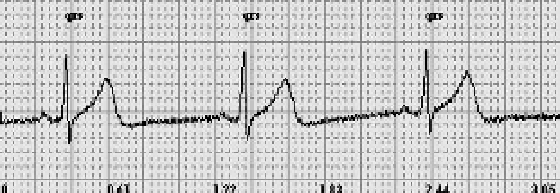Image Processing Reference
In-Depth Information
Fig. 9. Triangle Signal obtained by the A/D Change Module
Fig. 10. ECG Signal obtained by the A/D Change Module
4. ECG signal processing
(Vidal & Pavesi, 2004; Vidal & Gatica, 2010) worked on the digital filters application to
eliminate noise on an ECG signal, and the use of algorithms for QRS complex detecting.
Following subsections describe digital filters to work on the ECG signal, and present the
main principles of a QRS detector algorithm (Vidal et al., 2008).
4.1 Digital filters for ECG signal
To work the ECG signal it is necessary to apply digital filters which helps to diminish the
noise present on it. One of the most useful filters is Lynn's filters (Goldschlager, 1989) and
there are previous works where Lynn's filters are successfully applied to processing ECG
signal (Thakor et al., 1984; Kohler et al., 2002; Ahlstrom & Tompkins, 1985). These filters
present desirable properties of real-time filters like lineal phase and integer coefficients.
There are low-pass and high-pass Lynn's filters versions which are described as follows.
4.1.1 Low-pass filter
Lynn's filters described in (Ahlstrom & Tompkins, 1985) and used on ECG signal processing
in (Pan & Tompkins, 1985; Hamilton & Tompkins, 1986), represent a simple and effective
form of applying low-pass filter on ECG signals. These filters obey the next transfer
function:
2
2
(1
z
)
(1
2
z
z
)
Hz
()
(1)
12
1
2
(1
z
)
(1
2
z
z
)
This filter can be implemented by means of the following differences equation:
yn
[] 2[
yn
1]
yn
[
2]
xn
[] 2[
xn
]
xn
[
2 ]
(2)




